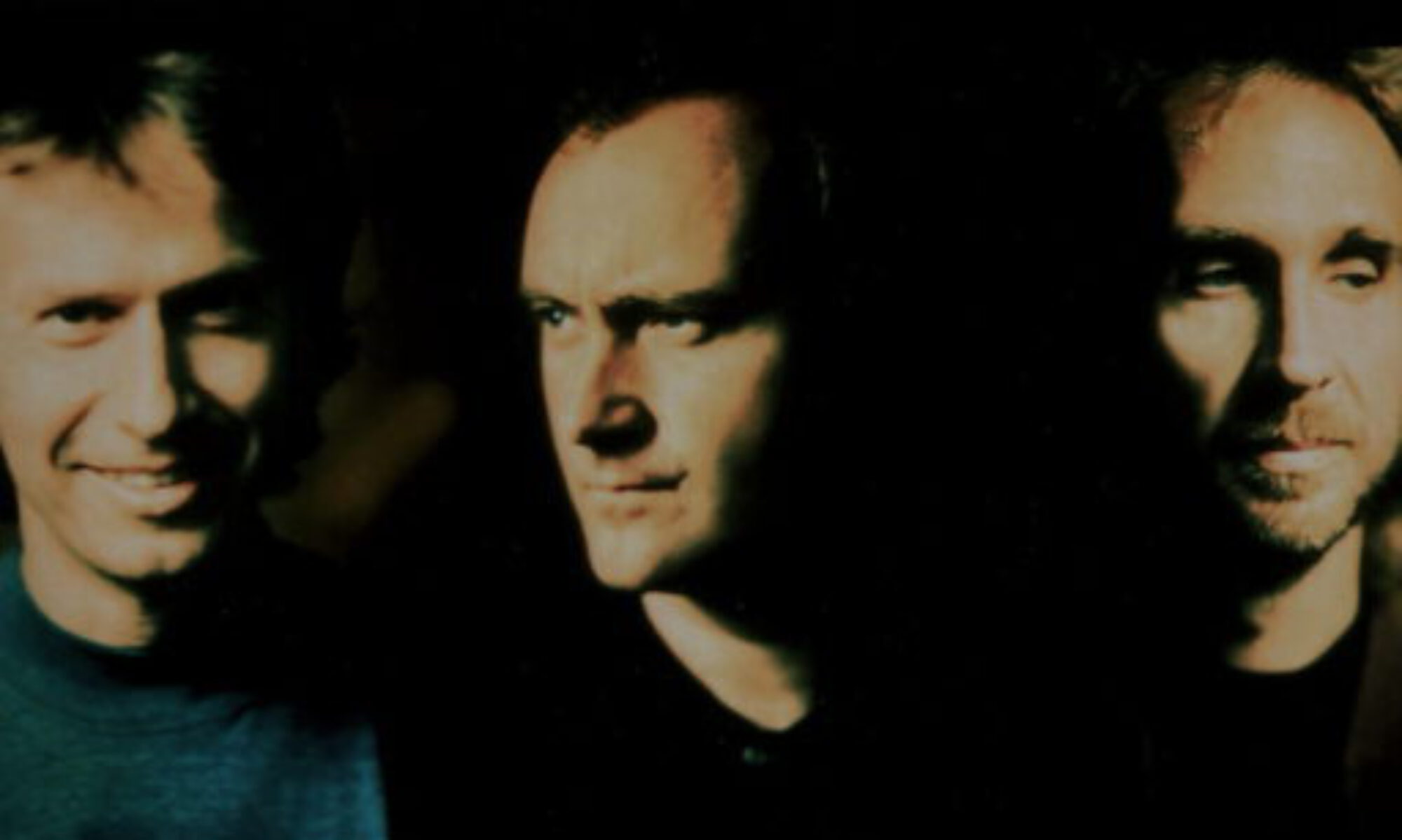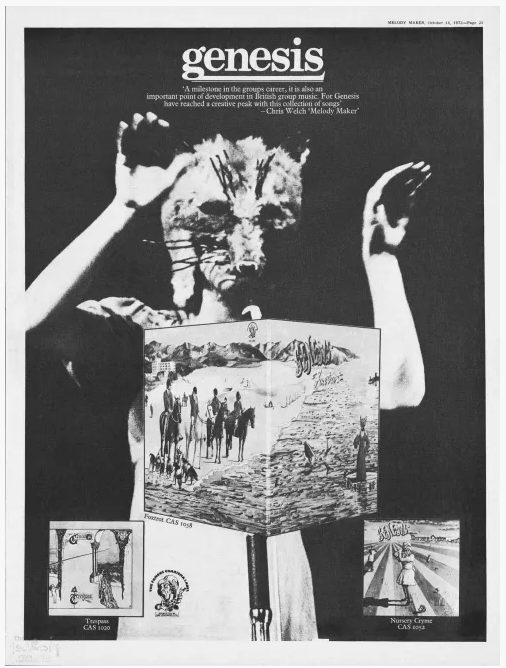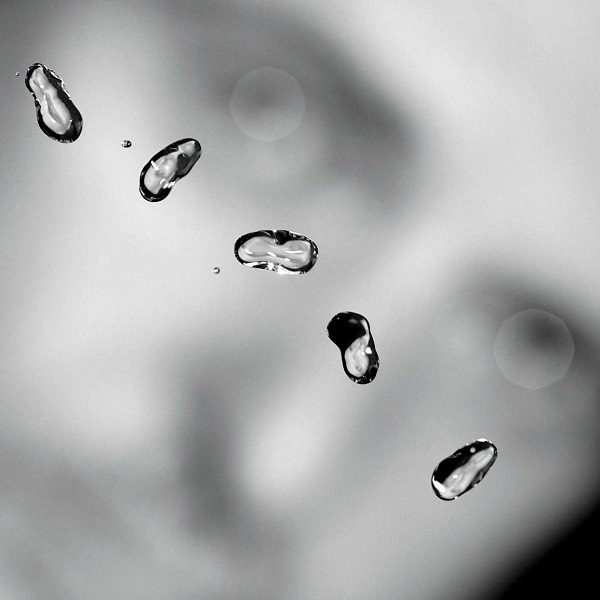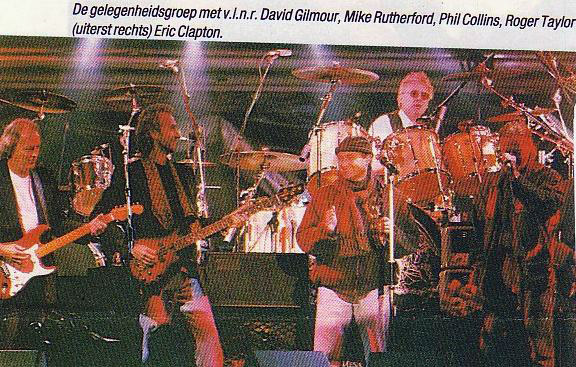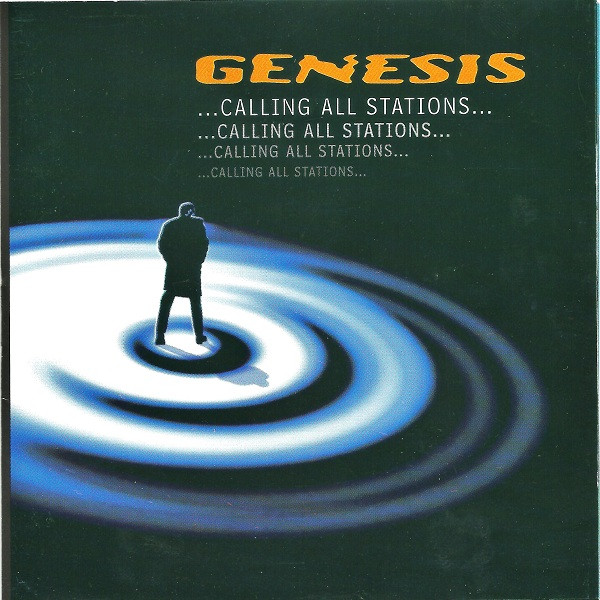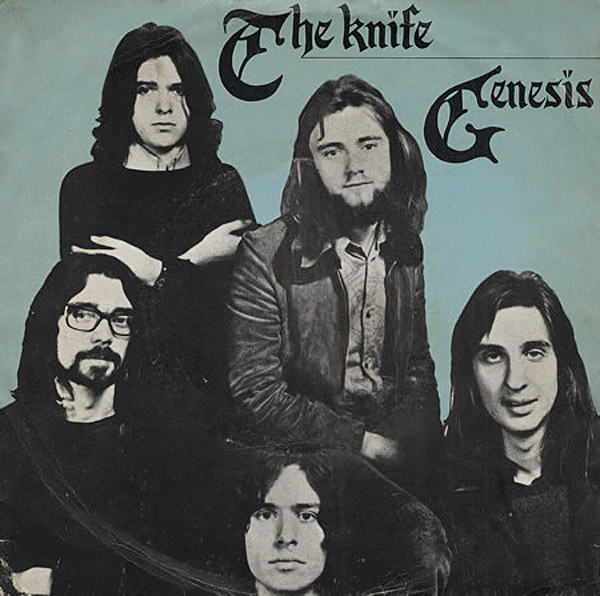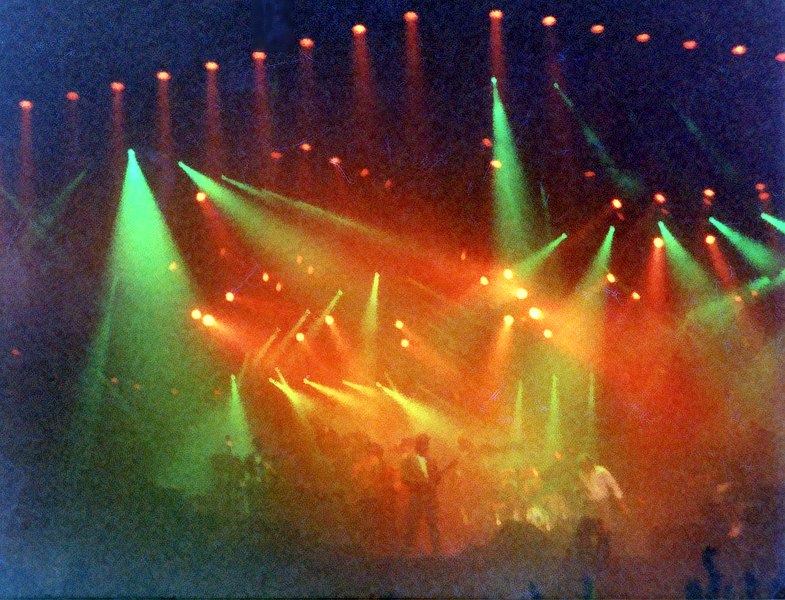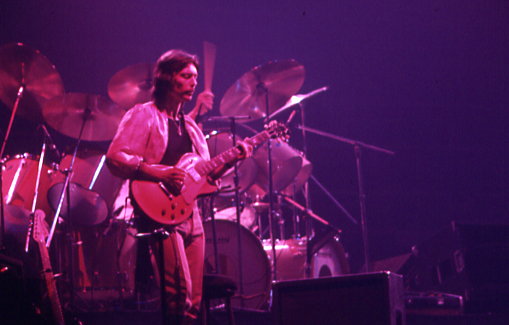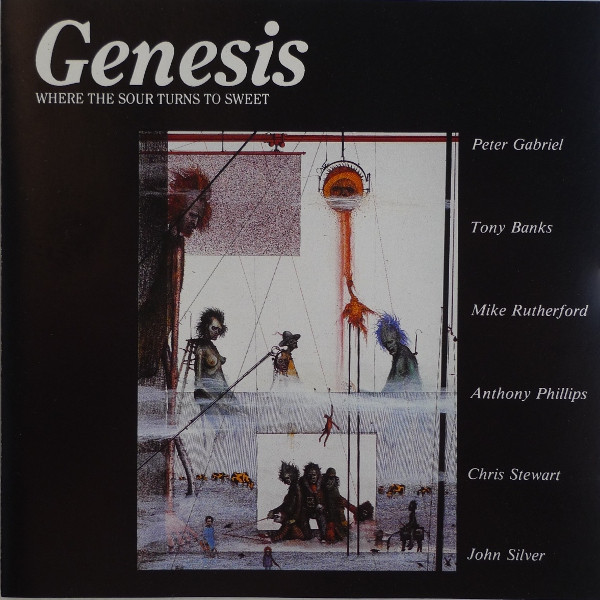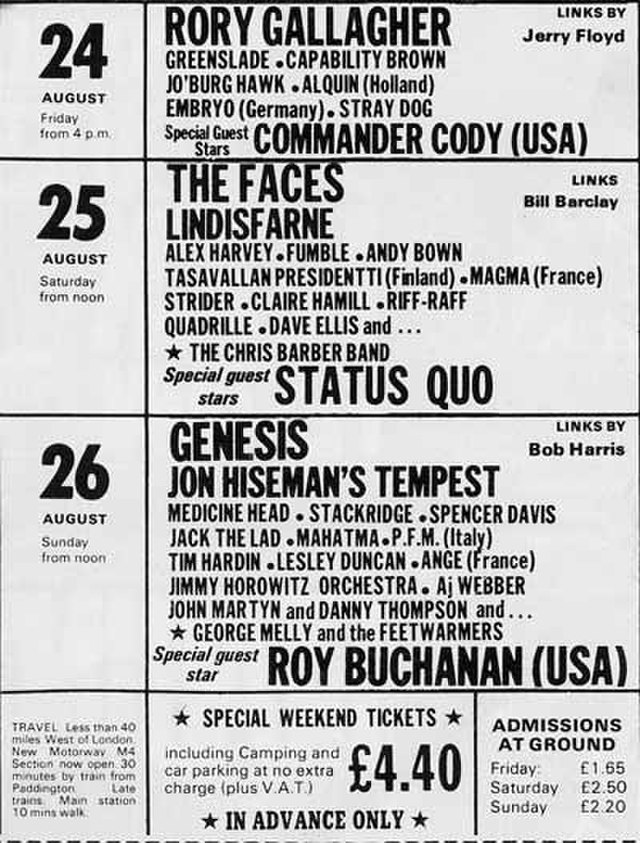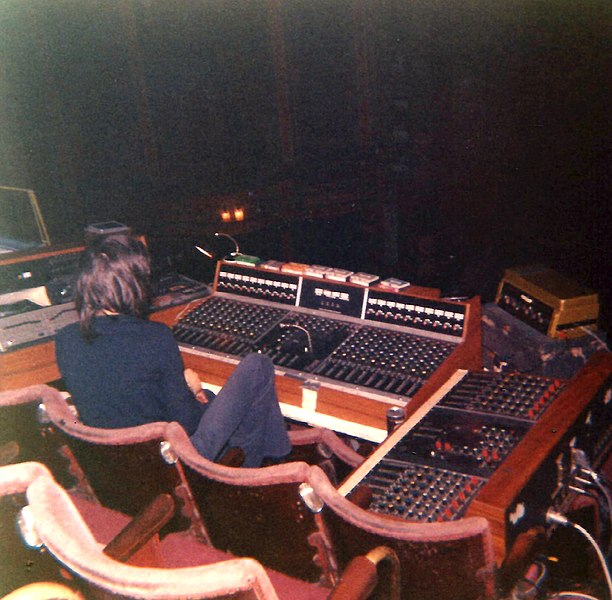On 28 September 1972, Genesis singer Peter Gabriel shocked both his bandmates and the audience in Dublin when he appeared during The Musical Box wearing a fox’s head and a long red dress, the same striking image that would grace the cover of Foxtrot.
Continue reading “Dublin, 28 September 1972: Peter Gabriel steps onstage in a fox head and red dress”Up (2002) – Peter Gabriel
On 23 September 2002, Peter Gabriel’s album Up was released.
Continue reading “Up (2002) – Peter Gabriel”Phil Collins’ Last Gig with Genesis at Cowdray Ruins, 18 September 1993
On 18 September 1993, Genesis gave what would turn out to be Phil Collins’ final live performance with the band: an understated charity concert at the historic Cowdray Ruins in Sussex.
Genesis in 1993
1993 was a relatively quiet year for Genesis. Following their massive We Can’t Dance tour in 1992, the members returned to their solo projects. For Phil Collins, it was a turbulent time. His marriage to his second wife, Jill, was breaking down under heavy tabloid scrutiny, and he poured much of that emotion into his solo album Both Sides. Dark, angry, and intensely personal, the album divided critics, something that weighed heavily on him.
Against this backdrop, Genesis regrouped briefly for a one-off charity concert at Cowdray Ruins. The show raised funds for the King Edward VII Hospice and featured an extraordinary lineup, including Pink Floyd and the surviving members of Queen.
A unique Genesis lineup
That night, Genesis appeared without their regular touring partners Chester Thompson and Daryl Stuermer. Instead, the drums were handled by Roger Taylor (Queen) and Gary Wallis (Mike + The Mechanics), while Tim Renwick (Pink Floyd, Mike + The Mechanics) filled in on guitar and bass.
Genesis performed a short set including “Turn It On Again,” “Hold On My Heart,” “I Can’t Dance,” and a “Tonight, Tonight, Tonight / Invisible Touch” medley. Some sources claim they also played Collins’ solo track “That’s Just the Way It Is,” though this remains doubtful.
Next, Pink Floyd took the stage, with Paul Young (Mike + The Mechanics) providing vocals on some numbers and Mike Rutherford stepping in on bass. Eric Clapton also performed a short set with Mike on bass, before the night ended with the “All Star Cowdray Ruins Band,” featuring nearly everyone involved, running through “Ain’t That Peculiar,” “Can I Get a Witness,” and “Gimme Some Lovin’.”
Low-quality recordings of the event survive on YouTube, but unfortunately no professional release exists, something of a shame, given its historical importance.
Phil’s reflections
Although successful, the concert was modest in scale. Few realized it marked the end of Collins’ 18-year run fronting Genesis. For Phil, the show highlighted his growing distance from the band:
“In the middle of my writing and making BOTH SIDES, Genesis did a concert with Queen. […] But I didn’t enjoy it … As I was singing these songs, it didn’t feel natural. Obviously, it was bad timing, going just like that from doing my most personal thing to a Genesis thing and back. But it definitely felt like ‘What am I doing here?’, like shoes that don’t fit anymore.“1
Though he wouldn’t announce his departure until 1996, the seeds had been sown that evening.
The Cowdray Ruins line-up (as listed in the program):
- Tony Banks – Genesis (keyboards)
- Eric Clapton – guitar
- Phil Collins – Genesis (vocals)
- John Deacon – Queen (bass)
- David Gilmour – Pink Floyd (guitar)
- Adrian Lee – Mike + The Mechanics (keyboards)
- Nick Mason – Pink Floyd (drums)
- Tim Renwick – Mike + The Mechanics / Pink Floyd (bass, guitar)
- Mike Rutherford – Genesis (guitar, bass)
- Roger Taylor – Queen (vocals, drums)
- Garry Wallis – drums
- Richard Wright – Pink Floyd (keyboards)
- Paul Young – Mike + The Mechanics (vocals)
Phil’s departure was still a few years away from being official. But looking back, Cowdray Ruins was the true closing chapter of his time with Genesis.
Sources
Hewitt, Alan (2000): Opening The Musical Box. London: Firefly Publishing.
Platts, Robin (2007): Genesis. Behind the lines, 1967-2007. Burlington, Ont., Canada: Collectors Guide Pub.
Thompson, Dave (2005): Turn it on again. Peter Gabriel, Phil Collins & Genesis. San Francisco: Backbeat Books.
- in Platts 2007: 140 ↩︎
Calling All Stations (1997) – Genesis
After Phil Collins’ departure from Genesis in 1996, the remaining two members Tony Banks and Mike Rutherford kept writing music and hired a new singer: Ray Wilson, born in 1968, known as lead vocalist of the band Stiltskin.
Continue reading “Calling All Stations (1997) – Genesis”How Phil Collins Joined Genesis
On 4 August 1970, Phil Collins officially became the drummer for Genesis. Here’s the story of how he landed the gig, and how it all began with a swim.
‘Looking for someone…’
By the summer of 1970, Genesis had just suffered what they later described as the biggest loss in their career: guitarist and founding member Anthony Phillips had decided to leave the band. Though the music on Trespass was complete, Ant’s struggle with stage fright made it impossible for him to continue performing. With his departure, Genesis (then a quartet) decided it was time to look for a new guitarist and, crucially, a new drummer.
Up until that point, they had gone through three different drummers. So, they placed an anonymous ad in Melody Maker, the go-to magazine for musicians in the UK:
‘TONY STRATTON SMITH is looking for 12-STRING GUITARIST who can also play lead; plus DRUMMER sensitive to acoustic music.’
One aspiring young drummer in London happened to see it: Phil Collins.
Answering the call
Phil had previously played in a band called Flaming Youth (originally named Hickory) and released one album with them. But the band never took off, rarely performed live, and left Phil frustrated and eager for something new. Determined to pursue a career as a professional drummer, he began scanning Melody Maker for new opportunities.
He recognised the name of the band’s manager, Tony Stratton-Smith, from his earlier music ventures and knew he could often be found at the bar in London’s Marquee Club. So Phil turned up and asked directly if he could audition for the band. Stratton-Smith responded that the band insisted on auditions for everyone. The band, he revealed, was Genesis. Phil had seen their name in the back pages of Melody Maker listings, but didn’t know much about their music.
At the time, Genesis was a trio: Tony Banks on keyboards, Peter Gabriel on vocals, and Mike Rutherford on guitar and bass. Phil recalls calling them and speaking with Peter Gabriel:
‘He said ‘Yes, uhm, come down to my parents’ house in Chobham.”
Peter was intrigued when Phil mentioned he had played with George Harrison. (Phil would later admit that all he had done was play percussion on one of George’s sessions, but the name-drop got his foot in the door.)
The audition (and the swimming pool)
Phil and his friend, guitarist Ronnie Caryl, drove out to the Gabriels’ countryside home near Woking on a hot summer day. The house had a pool and was surrounded by fields. Ronnie was hoping to join the band too.
Phil remembers seeing Mike Rutherford in what looked like a crushed velvet dressing gown and slippers. (Mike insists it was just a swimsuit and robe – they were by the pool, after all.) Tony Banks barely spoke and struck Phil as a ‘tortured artist.’ Peter Gabriel seemed eccentric.
They’d arrived early, and there were still a few drummers ahead of Phil. While waiting, they were invited to take a swim.
‘Being there early and having two or three drummers ahead of me, I didn’t know what the conversation was, what they were saying to each other, but I could hear the music. The same piece of music being played two or three times and the same piece of music being played with the next guy two or three times. So by the time I came up to play, I kind of felt I knew what I was doing.’
The band played pieces that showed the different styles Genesis was experimenting with: delicate passages, heavier sections, and more experimental parts. Phil listened to the Trespass album in the living room and was struck by the harmonies that reminded him of Crosby, Stills & Nash. He later said he would’ve joined them even if he hadn’t liked the music: he simply needed a job.
Thanks to the sneak preview while in the pool, Phil nailed the audition.
Peter Gabriel later said:
‘Just the way he sat down on the stool, I knew he was going to be good. Some people have this sort of confidence about what they do.’
After they left, Ronnie thought Phil had failed the audition but that he had done great. As we know, it turned out the other way around. Phil got the job. Ronnie didn’t, but he did end up playing in Phil’s solo band years later.
Fitting into the band
Phil, then just 19, joined Genesis in August 1970. The band took a short holiday before getting back together to rehearse in a space called Farnham Maltings, which Mike’s father helped them rent. Over six weeks, they began working on what would become Nursery Cryme.
Phil immediately noticed the cultural gap between him and the others. He was a working-class lad with a grammar and stage school background. The others were Charterhouse-educated public school boys. He recalls seeing Tony Banks and thinking he looked like Beethoven with his long hair.
Peter Gabriel, meanwhile, had a bass drum next to his mic stand, which he would bang on spontaneously, even out of rhythm. This annoyed Phil.
The atmosphere in the band was intense. Tensions ran high, especially between Peter and Tony.
‘In the middle of a conversation, suddenly someone would get up and slam a guitar on the floor and walk out‘, Phil remembers. ‘I thought ‘What?’ Someone had said something to upset somebody else. Two hours later this person would come back and we’d start playing again. Suddenly there’d be ‘Oh, f*** you’ and somebody else walked out. It was very highly strung.’
Peter Gabriel adds:
‘I would often be at loggerheads with Tony Banks, and Phil would always sit on the fence, he would never want to come into the argument.’
Phil’s different background influenced more than just the sound. It affected the group’s dynamics. He realised early on that his role included defusing arguments with humour, a skill that came naturally from his time at stage school.
Mike Rutherford recalls:
‘Apart from the humour, he’s got a very laid-back approach. He was very serious about his work, but had a very laid-back approach to life, which I think helped us a little bit.‘
Phil may have thought he was joining a band that held rehearsals by a pool in the countryside. In reality, he’d just signed up for years of rough touring in a van. But the chemistry was right and the rest is history.
Title photo: Genesis – ‘The Knife’ (single cover).
Sources
Phil Collins – A Life Less Ordinary (documentary, 2002)
Genesis – Sum of the Parts (documentary, 2014)
Philipp Röttgers – Two eras of Genesis? The development of a rock band (book, 2015)
The End of the Invisible Touch Tour – Wembley, July 4, 1987
On July 4, 1987, Genesis wrapped up their massive Invisible Touch tour with the fourth consecutive sold-out show at Wembley Stadium. It marked the end of a historic run for the band and a high point in their live career.
Invisible Touch: The Album
Released in 1986, Invisible Touch became Genesis’ most commercially successful album, reaching #1 in the UK and #3 in the US. It produced five major hit singles: ‘Invisible Touch’, ‘Tonight Tonight Tonight’, ‘Land of Confusion’, ‘In Too Deep’ and ‘Throwing It All Away’. Tracks like the title song, the moody Tonight, Tonight, Tonight, and Land of Confusion with its iconic Spitting Image video dominated radio, MTV, and the charts throughout 1986 and 1987. Genesis had never been more visible – or more popular.
Naturally, the band embarked on a massive world tour, playing across North America, Australia, Japan, Europe, and finally closing with four sold-out nights at Wembley, playing to nearly 300,000 people.
The Invisible Touch Tour
The tour kicked off in September 1986 in the US and included 112 shows, selling close to two million tickets. The band was joined, as usual, by drummer Chester Thompson and guitarist/bassist Daryl Stuermer.
In Australia and New Zealand, Genesis added a local four-piece string section for In Too Deep and Your Own Special Way, due to union regulations requiring them to employ local musicians.
By this point, Genesis weren’t just a hit-making machine, they were a finely-tuned live band, backed by a state-of-the-art Vari-Lite lighting system and a tight, polished setlist. While they had a vast catalogue to choose from, the shows leaned heavily on songs from Invisible Touch and recent albums.
The Setlist and Show Highlights
Every show opened with Mama, though its eerie atmosphere did not always translate well in daylight stadium settings. The closer was the now-iconic Turn It On Again medley, which featured a whirlwind of rock classics: Everybody Needs Somebody to Love, Satisfaction, Twist and Shout, Pinball Wizard, All Day and All of the Night and Karma Chameleon.
Older fan favorites included: Los Endos, Home By The Sea (with its now-standard ghost-story intro) and the In The Cage medley.
At the beginning of the tour, the In the Cage medley included In That Quiet Earth and the second half of Supper’s Ready. But as the tour progressed, Phil Collins began having trouble hitting some of the higher notes in Supper’s Ready, and the band eventually returned to the familiar In That Quiet Earth / Afterglow ending.
New material from Invisible Touch featured heavily, with standout performances of: Domino (with Phil’s now-legendary audience interaction), Tonight, Tonight, Tonight, Throwing It All Away (where the crowd singalong grew with each night) and Invisible Touch.
Live at Wembley Stadium
‘Nearly 300,000 people at Wembley. OK, there might have been a few repeats in there, but I thought at the time, and I still think now, that moment was the peak of our career’1 – Tony Banks.
By the time Genesis arrived at Wembley, the band had performed the set so often it had become a masterclass in musicianship and stagecraft. Initially, only two nights at Wembley were planned, but due to overwhelming demand, two more were added, making Genesis the first band to play four sold-out shows at Wembley Stadium. They entered the Guinness Book of Records, a record later broken by Michael Jackson during his Bad tour in 1988.
The Wembley concerts were filmed and later released on VHS and DVD (2003). Unfortunately, the epic In the Cage medley did not make it into the final release, (allegedly) due to bad luck with tape changes during that very song on each night.
Even so, the performance captured at Wembley is phenomenal, showcasing Genesis at their live peak. With Invisible Touch, the band had reached global superstardom and Wembley was the victory lap.
After this triumph, fans would have to wait four more years for the next Genesis studio album.
Title photo: Genesis Nancy 1987. Phil Collins, Tony Banks, Mike Rutherford, Daryl Stuermer, Chester Thompson. Genesis en concert à Nancy le 14 juin 1987 au stade Marcel-Picot de Nancy-Tomblaine Source: Wikimedia Commons, Fredamas / CC-BY-SA-2.5 (https://creativecommons.org/licenses/by/3.0).
- in Banks, Tony; Collins, Phil; Gabriel, Peter; Hackett, Steve; Rutherford, Mike; Dodd, Philip, Genesis. Chapter & verse. (New York: Thomas Dunne Books/St. Martin’s Griffin, 2007), p. 287. ↩︎
Steve Hackett’s Last Show with Genesis
On July 3, 1977, Genesis played the final show of their Wind & Wuthering tour, unaware that it would also be Steve Hackett’s last performance with the band.
Wind & Wuthering and Growing Tensions
Released in December 1976, Wind & Wuthering was Genesis’s second album following Peter Gabriel’s departure. With Phil Collins now stepping confidently into the role of lead vocalist, the band had successfully reinvented itself as a four-piece. Collins had already proven he could carry the frontman role with A Trick of the Tail and the subsequent 1976 tour.
By this point, songwriting duties were largely shared between Tony Banks and Mike Rutherford, while Phil focused more on arrangements and performance. Steve Hackett, however, was growing increasingly frustrated. He felt that his musical ideas were often overlooked, and after the 1977 tour, he made the decision to leave Genesis.
The Wind & Wuthering Tour
The 1977 tour was one of Genesis’s biggest yet, taking them across Europe, the US, and for the first time, South America. They were joined by American drummer Chester Thompson, who would become a fixture in the live lineup for decades.
That year, the band reached new heights in live performance and was even voted “Best Live Group” in 1977. Much of that era’s power was captured on the double live album Seconds Out.
The Final Show: July 3, 1977, Munich
Genesis closed out the tour with a concert at Munich’s Olympiahalle. They opened with Squonk, followed by One for the Vine, a Tony Banks epic from the new album. The rare track Inside and Out from the Spot the Pigeon EP was also included, having appeared on select European dates.
Highlights of the show included The Carpet Crawlers, I Know What I Like, and Supper’s Ready, songs that had evolved significantly since Gabriel’s departure. The band had also begun experimenting with medleys, a trend that continued on this tour: Dance on a Volcano merged seamlessly into Los Endos, while The Lamb Lies Down on Broadway was paired with the climactic ending of The Musical Box.
And of course, Firth of Fifth made the setlist, featuring Hackett’s iconic guitar solo. None of the fans, or even the band members, knew it would be the last time they’d see Steve Hackett perform it live with Genesis.
Steve Hackett’s Departure
Steve had already released a solo album by this point, showcasing ideas that had not made it onto Genesis records. During the four-piece era, he had pushed for a guaranteed portion of writing credits on each album, a request the others declined, committed as they were to being a fully democratic group.
In July 1977, while mixing Seconds Out, Hackett found himself exhausted by the constant repetition of songs like I Know What I Like. After months on the road and in front of crowds of 20,000 people, he began to feel creatively stifled. The challenge was gone.
So one day, he picked up the phone and called Mike Rutherford to say he was leaving. Mike, aware of Steve’s growing dissatisfaction, did not try to change his mind.
Shortly afterward, Phil Collins happened to drive past Steve near Trident Studios, where they were mixing the album. Phil invited him into the car, but Steve acted strangely, saying only, “Talk to Mike, he’ll explain,” before walking away. When Phil arrived at the studio, Mike and Tony told him Steve had officially left the band.
The Band Carries On
Genesis continued mixing Seconds Out as a trio, then returned to the studio to begin work on their next album. From this point forward, Genesis would remain a three-piece studio band, while Steve Hackett would embark on a successful solo career.
Title photo: Genesis Steve Hackett. Source: Wikimedia Commons, Jean-Luc / CC-BY-SA-2.5 (https://creativecommons.org/licenses/by/3.0). Originally posted to Flickr as Genesis.
Where the Sour Turns to Sweet (1969) – Genesis
In June 1969, Genesis released their third and final single for Decca Records: “Where the Sour Turns to Sweet” backed with “In Hiding.” It was intended to spark interest in their debut LP From Genesis to Revelation, but like its predecessors, it went largely unnoticed.
From Genesis to Revelation
By this point, Genesis had already released two singles on Decca: “The Silent Sun” and “A Winter’s Tale,” both in 1968 and both produced by Jonathan King. King also produced the band’s first full-length album, From Genesis to Revelation. The lineup at the time featured Tony Banks (keyboards), Peter Gabriel (vocals), Anthony Phillips (guitar), Mike Rutherford (guitar/bass), and John Silver (drums).
The album, loosely a concept work about the history of mankind, was still musically rooted in soft pop rather than progressive rock. Much to the band’s dismay, King added string arrangements to many tracks, softening the overall sound and steering it further from the band’s original vision.
Like the singles before it, the album failed to attract significant attention. In an effort to salvage interest, Decca decided to release a third single from the LP: “Where the Sour Turns to Sweet.”
Where the Sour Turns to Sweet
The track had actually been part of Genesis’s live repertoire for a while. Back in 1967, they recorded it, along with three other songs, during a one-hour session at Regent Sound Studios in London (where many rock legends had also worked). Jonathan King brought the young band in to record a demo, which was then sent to Decca. The label was impressed, and the band was signed.
They attempted to re-record “Where the Sour Turns to Sweet” at Advision Studios as their debut single, but the session was a disaster. Inexperience on both the band’s and producer’s parts led to the idea being shelved. Instead, “The Silent Sun” and “A Winter’s Tale” were released the following year, along with the full album in 1969.
Finally, on June 27, 1969, “Where the Sour Turns to Sweet” was released as a single (using the album version) with “In Hiding” as the B-side. It became Genesis’s third and last Decca single. Like the others, it failed to chart. There were even plans to release a remixed version of “In the Beginning” as a fourth single, but they never materialized.
Musical Highlights
“Where the Sour Turns to Sweet” opens with a bluesy piano phrase and finger snaps, giving it a laid-back, jazzy feel. Unfortunately, Arthur Greenslade’s added strings somewhat obscure the song’s raw energy. Peter Gabriel’s voice, even at this early stage, stands ou. His playful delivery and dynamic phrasing give the lyrics character and charm. It’s arguably one of the album’s standout tracks, though the fade-out feels abrupt and slightly uninspired.
Tony Banks and Tony Blackburn
Keyboardist Tony Banks once recalled being sent out to accost BBC DJ Tony Blackburn on the street to persuade him to play the single on his radio show (though Mike Rutherford claims that this was done when “A Winter’s Tale” was released.) “I told him, ‘Well, don’t play the A-side—play the B-side,’” Banks later said, referring to “In Hiding.” The situation was awkward for everyone involved, but the band was desperate enough to take the chance.
The End of the King Era
By the end of 1969, after three underwhelming singles and an album that missed the mark, Genesis was ready to move on. Jonathan King had taken the group as far as he could. The band withdrew to the countryside to reflect and write new music that would take them in a very different, much more adventurous direction.
Still, King left them with one important legacy: the name Genesis.
Genesis at Reading Festival 1971
Peter Gabriel performs with a broken ankle – and Genesis gain new fans
On 26 June 1971, Genesis performed at the Reading Festival for the very first time. Back then, they were still low on the bill, sharing the lineup with artists such as Lindisfarne, Terry Reid, Renaissance and Sha Na Na. Like many festivals, it came with its share of challenges: rain, mud, and even an unexpected police squad, but Genesis had a unique complication of their own: Peter Gabriel had recently broken his ankle.
The accident at Friars Club
Just a week earlier, on 19 June, Genesis had played a show at Friars in Aylesbury. During the encore of The Knife, Gabriel, always the theatrical frontman, leapt off the stage into the crowd. Unfortunately, the audience parted rather than caught him. He hit the floor hard and fractured his ankle.
Despite the injury, the band pressed on. Gabriel famously performed at least one subsequent gig in a wheelchair at an art college in Lincoln. Richard Macphail, Genesis’s tour manager and longtime friend, recalled the chaos:
‘And it scared the pants of me, because the stage was like a traditional theatre stage that sloped towards the audience. He was wildly cavorting in this wheelchair on this stage. I thought he was going to fall off the stage and break his neck!’1
Thankfully, he did not and just a few days later, Genesis took the stage at Reading.
Reading Festival in 1971
The 11th National Jazz and Blues Festival was held in Reading for the first time in 1971. The festival had previously moved between locations including Richmond, Windsor, Sunbury, and Plumpton due to local complaints. That year, it finally found a home in Reading, taking place at the Thames-side Arena on Richfield Avenue, over 25–27 June.
The event was rebranded as the Reading Festival of Folk and Progressive Music, with a ticket for Saturday, 26 June, priced at just £1.50. Although Reading Festival is typically held in August today, it’s unclear why it took place in June that year, perhaps due to the town’s 1000th anniversary celebrations, which had helped organizer Harold Pendleton gain approval from the local council.
Sharing the stage with Charisma labelmates
Genesis were not the only Charisma Records act at Reading in 1971. Lindisfarne, Van der Graaf Generator, Bell & Arc, and Audience also performed, alongside other notable names like Arthur Brown, Rory Gallagher, Wishbone Ash, Osibisa, and Ralph McTell.
Genesis played mid-afternoon on the festival’s second day. Despite their relatively low billing, their set was highlighted as one of the standout performances of the weekend. The impact was strong enough that they were invited back in the following two years.
A new era: Genesis and the festival circuit
That summer marked the beginning of Genesis’s appearances at outdoor rock festivals. Steve Hackett later recalled that it rained nearly every time they played an outdoor show in England or Europe, turning every venue into a mud bath.
At Reading, technical issues added to the frustration. Power fluctuations made it nearly impossible to keep instruments in tune. The organ was already difficult to manage, and the Mellotron, notorious for its fragility, was even worse. Their twelve-string guitars, tuned backstage, were often already out of tune by the time they hit the stage and tuning a twelve-string in front of a festival crowd was nearly impossible.
Not made for festivals?
Looking back, Tony Banks admitted that Genesis were not ideally suited for the festival scene in those early years. The broad daylight made it difficult to create a dramatic atmosphere, the audiences did not always appreciate the complex song structures, and sound quality was often poor.
Still, the band slowly built a reputation as a strong live act and festivals helped them reach new fans. The real magic, though, happened after dark, when they could perform for their own audiences in a controlled setting.
But even at this early stage, they were beginning to leave an impression. At Reading 1971, some fans in the crowd already waved Genesis flags, signaling that the band’s dedicated following was starting to take shape.
Photo: Reading Festival Line Up 1973. Reading-festivaalin vuoden 1973 esiintyjälista Source: Wikimedia Commons, National Jazz, Blues and Rock Festival. / CC-BY-SA-2.5 (https://creativecommons.org/licenses/by/3.0).
- Platts, Robin, Genesis. Behind the lines, 1967-2007. (Burlington, Ont., Canada: Collectors Guide Pub., 2007), p. 44. ↩︎
Genesis’ First Gig Abroad: Belgium, March 7, 1971
Genesis played their first-ever overseas concert on March 7, 1971, at La Ferme in Woluwe St. Lambert, Belgium. This landmark performance marked a significant step in the band’s journey, as they ventured beyond the UK for the first time.
Trespass Had Charted in Belgium
At the start of 1971, Genesis had yet to achieve major success in their home country. However, things were different on the continent: their second album, Trespass, had reached number one in Belgium. Encouraged by this unexpected success, the band – now featuring new members Phil Collins on drums and Steve Hackett on guitar – headed to Belgium for their first international show.
A Rough Journey Across the Channel
The band crossed the English Channel on an overnight ferry, but sleep was out of the question. Unable to afford cabins, they spent the night sitting on deck – while Phil, suffering from seasickness, spent most of it throwing up. Running on little more than beer and sandwiches, they arrived in Belgium the next morning, drove straight to the venue, and played.
The Setlist: A Mix of Old and New
The setlist featured songs from Trespass, live favorites, and two brand-new tracks. As was typical for Genesis at the time, the performance started with acoustic material before building up to heavier numbers. Fortunately, a recording of this historic gig exists, allowing us to hear most of the show (though some parts are missing). It also contains the only known live recording of the rare song “The Light”, which features early elements that would later evolve into The Lamb Lies Down on Broadway’s “Lilywhite Lilith.”
Opening with a New Song
The show began with the band’s latest composition, “Happy The Man” – introduced by Peter Gabriel as a song about a man who “eats his fingernails, probably.” Built around a Mike Rutherford riff, the song had a laid-back, folk-rock feel, reminiscent of Lindisfarne. It was an attempt at a radio-friendly single, and in this live version, it was performed at a slightly slower tempo.
Next came “Stagnation” from Trespass – which Gabriel jokingly described as being about “people with bad breath.” This live rendition, enhanced by Phil Collins’ drumming, had a swing that was missing from the studio version.
The Only Recorded Performance of “The Light”
After a few minutes of Peter’s humorous attempts to introduce the band, they launched into “The Light” – a rarity in Genesis’ catalog. The song’s opening bass riff would later be repurposed for “Lilywhite Lilith”, and Steve Hackett’s guitar parts would also find their way into that track. “The Light” then developed into a full-fledged progressive rock piece, featuring an extended instrumental jam between Tony Banks and Hackett. Eventually, the song returned to a section that closely resembled the later Lamb Lies Down classic. Compared to other Genesis compositions from this era, “The Light” stands out as a unique and intriguing experiment.
A Blend of Familiar and Unfinished Material
Next, the band slowed things down with “Twilight Alehouse”, a live staple at the time. The dramatic organ-driven climax showcased Tony Banks’ signature style. Then came another brand-new song: “The Musical Box”, which Peter introduced in both English and French. This early version was slightly different from the one that would appear on Nursery Cryme later that year. There was extra instrumental material before the “And the clock” section, which was repeated twice. Tony’s keyboard solo was extended, while Steve Hackett’s was shorter – unsurprising, as he had only been with the band for two months. Even the song’s now-iconic climax had subtle differences in Gabriel’s vocal delivery.
The band then launched into the Trespass classic “The Knife”, which Peter introduced in French. Tony’s organ led the charge, Mike Rutherford’s bass provided the driving force, and Steve Hackett – though still getting to grips with the song’s solos – delivered a strong performance by the end. Unfortunately, Peter’s flute section in the middle is missing from the recording. The audience, however, responded with enthusiasm, applauding loudly.
For the encore, Genesis performed “Going Out to Get You”, an early track that Peter described as “a very old number about passion.” Tony Banks dominated the piece, and Steve Hackett was barely audible – at times, it even seemed as if he wasn’t playing at all.
A Glimpse Into Genesis’ Creative Process
Listening to this rare recording is fascinating – not just because it includes unreleased songs, but also because it captures the band in the midst of developing their material, both musically and lyrically. Most notably, it features the only known live performance of “The Light”, making it an essential piece of Genesis history.
An Exhausting but Pivotal Moment
The concert was a success and a crucial milestone for Genesis. After the show, the exhausted band made their way back to the UK on the ferry, with Phil Collins limping home, nearly collapsing from sheer fatigue. Despite the rough journey, this first step into the international spotlight marked the beginning of Genesis’ rise as one of progressive rock’s most important bands.
Photo: FOH PA mixing desk and associated gear for Genesis at a concert in the Liverpool Empire, 1970s, precise year unknown. Source: Wikimedia Commons, Rodhullandemu / CC-BY-SA-2.5 (https://creativecommons.org/licenses/by/3.0).
